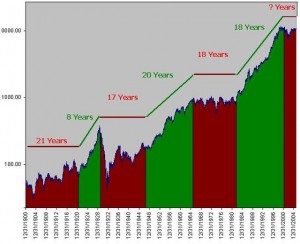18 Year Commodity Cycle
Whenever you are making investment decisions (especially those that affect your retirement plan) you need to be aware of two cycles that dramatically affect the markets.
1. Where we are in the business cycle (expansion or recession)
2. Where we are in the Stock / Commodity cycle.
Right now we are in the expansion phase of the business cycle, even though it’s not a very strong one. The key to the expansion has been the incredibly easy monetary policy and the endless liquidity provided by the federal reserve. So this cycle is positive for the stock market.
The Stock / Commodity Cycle however is still in favor of commodities for another decade. How does this cycle work? The chart below shows how the dow has performed over the past century, you can see that it tends to go up for about 18-20 years and then turns choppy for about the same length of time. During those choppy years is when the commodity booms have taken place, the last one being 1964-1982.
If you look at the last boom which encompassed the 1970’s you will see that the stock market action over those years looks remarkably similar to what we are experiencing right now. The stock market traded in a broad range and didn’t go anywhere for about 20 years. That’s easily what could happen this time as well, we have sharp sell offs and sharp rallies but really don’t go anywhere until the latter part of this next decade. That will also coincide with the rise of the baby boomers kids who will provide the next wave of heavy consumer spending as they begin to raise families.
The current cycle began in 2000 when the stock market peaked, commodities took off in late 2002 so expect the next major break out in the stock market to occur between 2018 and 2020. There can be new highs made in these next few years but it shouldn’t be anything significant. The real winners during this time period will most likely continue to be:
Gold Miners
Silver Miners
Energy Stocks
Ag Related Stocks
Basically anyone who is involved in producing or mining commodities should do pretty well. Those that use commodities and sell finished goods to consumers will be the laggards during this time frame. A perfect example of this right now are Jean Manufacturers as cotton prices have doubled in the past couple years.

